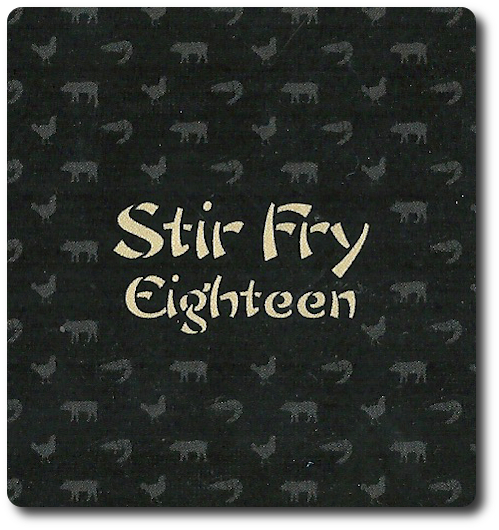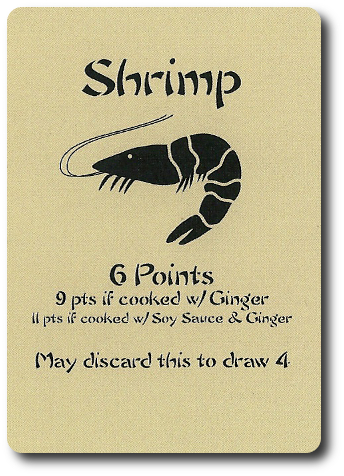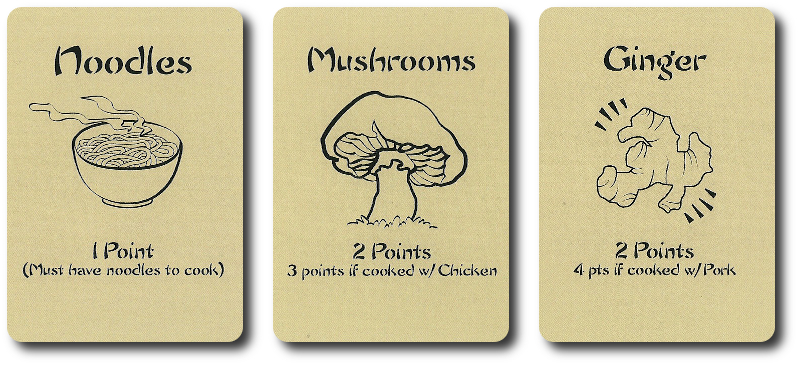
The Basics:
- For ages 7 and up (publisher suggests 6+)
- For 2 to 5 players
- Approximately 10 minutes to complete
Geek Skills:
- Active Listening & Communication
- Counting & Math
- Logical & Critical Decision Making
- Reading
- Memorization
- Risk vs. Reward
- Hand/Resource Management
- Bluffing and Misdirection
Learning Curve:
- Child – Easy
- Adult – Easy
Theme & Narrative:
- Are you King of the Kitchen?
Endorsements:
- Gamer Geek mixed!
- Parent Geek approved!
- Child Geek approved!
Overview
It has been said, by some (not me, per se), that cooking is an art form. Others will tell you that it’s a science. Still there are a few that will tell you to skip the whole cooking thing and just order off the menu. Whatever your preference and belief, it cannot be argued that cooking is a process that is one part creativity and one part chaos. In this game, what you make of chaos is based on creative card plays.
Stir Fry Eighteen, designed by Marshall Britt and published by Yanaguana Games, is comprised of 18 Ingredient cards. The cards are as thick and as durable as your standard playing card. The illustrations are minimal with little emphasis put on any eye candy. Not included with the game, but necessary to play, is a pen or pencil and a piece of paper to keep track of players’ scores.
Wok Fu
To play the game, shuffle the cards and deal 3 cards to each player (referred to as “Chefs”), face-down. Place the remaining cards face-down in the middle of the playing area to form the draw deck. A player’s turn is comprised of several steps that are taken in sequential order. These steps are summarized here.
Step 1: Draw One Card
The player draws 1 card from the draw deck and adds it to their hand. The player now has 4 Ingredient cards.
Step 2: Discard and Draw (Optional)
The player can discard 1 card at a time and draw a new card from the draw deck to replace it. When discarding, place the discarded cards face-down in a separate pile. This action can be done as many times as the player likes. When the draw deck is depleted, the discard pile is not shuffled to become the new draw deck until after the player ends their turn.
In addition, if a player discards a pair of matching cards (2 “Ginger”, for example), they may draw 3 new cards. If they discard a single “protein” type card (“Shrimp”, for example), they may draw a number of cards equal to the draw point value listed.

Discard 1 shrimp for 4 cards? What a deal!
These two special discard actions are only available to the player once per game. A player need never state exactly what they are discarding, but they must, at the least, let the opponents know what they are doing (just not necessarily with what cards).
Bluffing is also encouraged. A player can say something like, “I don’t need this chicken”, when they are actually discarding a “Shrimp”. What a player cannot do is break the rules in regards to matching pairs or discarding protein. These cards must be the type and quantity necessary.
Step 3: Stir Fry or Pass
A player can “cook” a stir fry using 3 to 5 cards. At least 1 of the Ingredient cards must be “Noodles” and each card used in the stir fry must be unique (no more than 1 of each ingredient type). The player lays out their cards and then counts their points, including any bonus points scored due to different Ingredient card combos, recording the total points earned on a sheet of paper.

This stir fry is worth 5 points!
Optionally, a player can elect to pass and skip right to step 4. This will ensure the player will not score any points this turn. However, it might be necessary so as to create the perfect (and very high scoring) stir fry for the player’s next turn!
Step 4: End of Turn
After scoring their points (or not), all the cards used in the stir fry are gathered up and placed in the discard pile. The discard pile and any remaining cards in the draw deck are then reshuffled together to create a new draw deck.
If the player cooked this turn, they draw 1 card and add it to their hand, but only if they have 2 or fewer cards in their hand. If they have more than 3, they must discard until they only have 3 cards in their hand. Any cards discarded should be shuffled back into the draw deck.
It’s now the next player’s turn.
Taste Testing
While bluffing is encourage from the very start, bluffs can be called by opponents at anytime during the game. Calling an opponent’s bluff is referred to as “Taste Testing” and can only occur when another opponent believes the card the player discarded was not accurately identified (the discarded “Shrimp” was actually a “Ginger”, for example). A player can only call for a Taste Test if they have at least 1 card in their hand or have at least 5 points.
As soon as the player is accused, the opponent flips over the discarded Ingredient card to reveal it.
- If the Ingredient card was accurately divulged, the accusing opponent must immediately discard all their cards. Or, if the accusing opponent doesn’t have any cards, they lose 5 points.
- If the Ingredient card was a blatant bluff, the accusing opponent is awarded an extra card during step 1 of their next turn.
Frying High!
The game continues until 1 player has scored 50 or more points at the end of their turn. This player is the winner and is awarded the title of Wok Overlord or whatever else you may think of.
Game Variants
A small number of game variants are available to spice things up after the base game has been played. Each are summarized here.
Close the Kitchen
Instead of the game ending after a player scores 50 or more points at the end of their turn, each player is given 1 additional turn to attempt to score as many points as possible. The player with the most points at the end of the game is the winner.
Variable Victory
Adjust the necessary points needed to win to either lengthen or shorten the game. Examples includes reducing the game length by setting the victory to 25 points or enjoying a longer game with a victory set at 300 points.
Empty Pantry
Players do not draw a card on their turn. This forces players to manage their cards as a limited resource and call for more Taste Tests.
To learn more about Stir Fry Eighteen, visit the game’s web page.
Final Word
 The Child Geeks jumped right in and took charge. The game it not difficult to learn and even simpler to play. But in this case, the game’s simplicity masks the underlying difficulty of winning the game. A player can score points each round if they play it safe, but will never advance quickly enough to be first in the winner’s circle. Players must bluff and take the risk of calling an opponent’s possible bluff. Victory is given to those who press their luck and aggressively pursue each and every point while limiting any chance of their opponents scoring big points. According to one Child Geek, “You quickly learn that it is not enough to just score points in the game. You have to limit what your opponents are doing.” Another Child Geek said, “There aren’t many cards, so you can remember most of what is being played. When another player says they are discarding a card you know they don’t have, it’s time to pounce!” When all the votes were in, the Child Geeks voted to approve Stir Fry Eighteen.
The Child Geeks jumped right in and took charge. The game it not difficult to learn and even simpler to play. But in this case, the game’s simplicity masks the underlying difficulty of winning the game. A player can score points each round if they play it safe, but will never advance quickly enough to be first in the winner’s circle. Players must bluff and take the risk of calling an opponent’s possible bluff. Victory is given to those who press their luck and aggressively pursue each and every point while limiting any chance of their opponents scoring big points. According to one Child Geek, “You quickly learn that it is not enough to just score points in the game. You have to limit what your opponents are doing.” Another Child Geek said, “There aren’t many cards, so you can remember most of what is being played. When another player says they are discarding a card you know they don’t have, it’s time to pounce!” When all the votes were in, the Child Geeks voted to approve Stir Fry Eighteen.
 The Parent Geeks also found a lot of value and fun in the game, likening it to Liars Dice at times due to the need to blatantly lie about what cards you are discarding. According to one Parent Geek, “You have to discard to get what you need, but even then, you have to keep what you are telling the group as simple as possible. Too much information will tip your hand, but too little will cause them to call you out. It’s an interesting balancing act.” Another Parent Geek said, “The biggest challenge is attempting to score as much as possible, but to do that, you have to keep yourself from saying too much. You really have to bluff your way from start to finish.” Since scores are always visible, it became quickly obvious who was in the lead and who was in desperate need to catch up. Knowing this, the Parent Geeks always reacted differently to players depending on how many points they had. This was quickly taken advantage of and the bluffing continued to get deeper and richer. When the games were over, the Parent Geeks voted to approve Stir Fry Eighteen.
The Parent Geeks also found a lot of value and fun in the game, likening it to Liars Dice at times due to the need to blatantly lie about what cards you are discarding. According to one Parent Geek, “You have to discard to get what you need, but even then, you have to keep what you are telling the group as simple as possible. Too much information will tip your hand, but too little will cause them to call you out. It’s an interesting balancing act.” Another Parent Geek said, “The biggest challenge is attempting to score as much as possible, but to do that, you have to keep yourself from saying too much. You really have to bluff your way from start to finish.” Since scores are always visible, it became quickly obvious who was in the lead and who was in desperate need to catch up. Knowing this, the Parent Geeks always reacted differently to players depending on how many points they had. This was quickly taken advantage of and the bluffing continued to get deeper and richer. When the games were over, the Parent Geeks voted to approve Stir Fry Eighteen.
 The Gamer Geeks were mixed when it came to the game. According to one supporter of Stir Fry Eighteen, “This little micro game has everything a game should have. Depth, bluffing, deduction, risk, reward, and even a bit of memory. I think it will go very well with my group when we want to play a game as a filler.” Another supporter said, “A descent micro-game. It challenged me and I had fun playing it. I guess that’s about as good as it gets.” But not everyone enjoyed the game. A detractor said, “Too simple. You can score points every turn without even trying. The worst part of the game is how simple it is to play. You don’t have to think much. Or maybe not at all.” Another detractor said, “The game is designed OK, but it’s repetitive. All you do is score points every turn and hope that you have just a few more than the other players so you can win. There isn’t much need to bluff and taking a risk isn’t worthwhile. I don’t care for it.” When all the votes were in, the vote was split, resulting in a mixed level of endorsement from the gaming elitists.
The Gamer Geeks were mixed when it came to the game. According to one supporter of Stir Fry Eighteen, “This little micro game has everything a game should have. Depth, bluffing, deduction, risk, reward, and even a bit of memory. I think it will go very well with my group when we want to play a game as a filler.” Another supporter said, “A descent micro-game. It challenged me and I had fun playing it. I guess that’s about as good as it gets.” But not everyone enjoyed the game. A detractor said, “Too simple. You can score points every turn without even trying. The worst part of the game is how simple it is to play. You don’t have to think much. Or maybe not at all.” Another detractor said, “The game is designed OK, but it’s repetitive. All you do is score points every turn and hope that you have just a few more than the other players so you can win. There isn’t much need to bluff and taking a risk isn’t worthwhile. I don’t care for it.” When all the votes were in, the vote was split, resulting in a mixed level of endorsement from the gaming elitists.
 Stir Fry Eighteen is perfect for those rare moments when you want a quick game but don’t have a lot of time or a lot of space to play one. It has been said that Stir Fry Eighteen is a micro-game and I am in agreement with this assessment. But there is also enough to the game to make it a quick filler, challenging players to not only memorize what cards have been played, but to bluff and deduce. There is more to this little game than first meets the eye, but not so much as to overfill one’s proverbial game plate. It has just the right amount of depth to keep players engaged, but not so deep as to demand anymore than 5 to 10 minutes of their time. Simply perfect for those waiting for a meal of their own to be served or breaks between larger games.
Stir Fry Eighteen is perfect for those rare moments when you want a quick game but don’t have a lot of time or a lot of space to play one. It has been said that Stir Fry Eighteen is a micro-game and I am in agreement with this assessment. But there is also enough to the game to make it a quick filler, challenging players to not only memorize what cards have been played, but to bluff and deduce. There is more to this little game than first meets the eye, but not so much as to overfill one’s proverbial game plate. It has just the right amount of depth to keep players engaged, but not so deep as to demand anymore than 5 to 10 minutes of their time. Simply perfect for those waiting for a meal of their own to be served or breaks between larger games.
If you are looking for a quick to play game of memory and bluffing, of deduction and risk taking, then do give Stir Fry Eighteen a try. While you might not be able to create high scores each turn, the game will most certainly cook up some fun for you and your opponents to chow down on.
This game was given to Father Geek as a review copy. Father Geek was not paid, bribed, wined, dined, or threatened in vain hopes of influencing this review. Such is the statuesque and legendary integrity of Father Geek.



